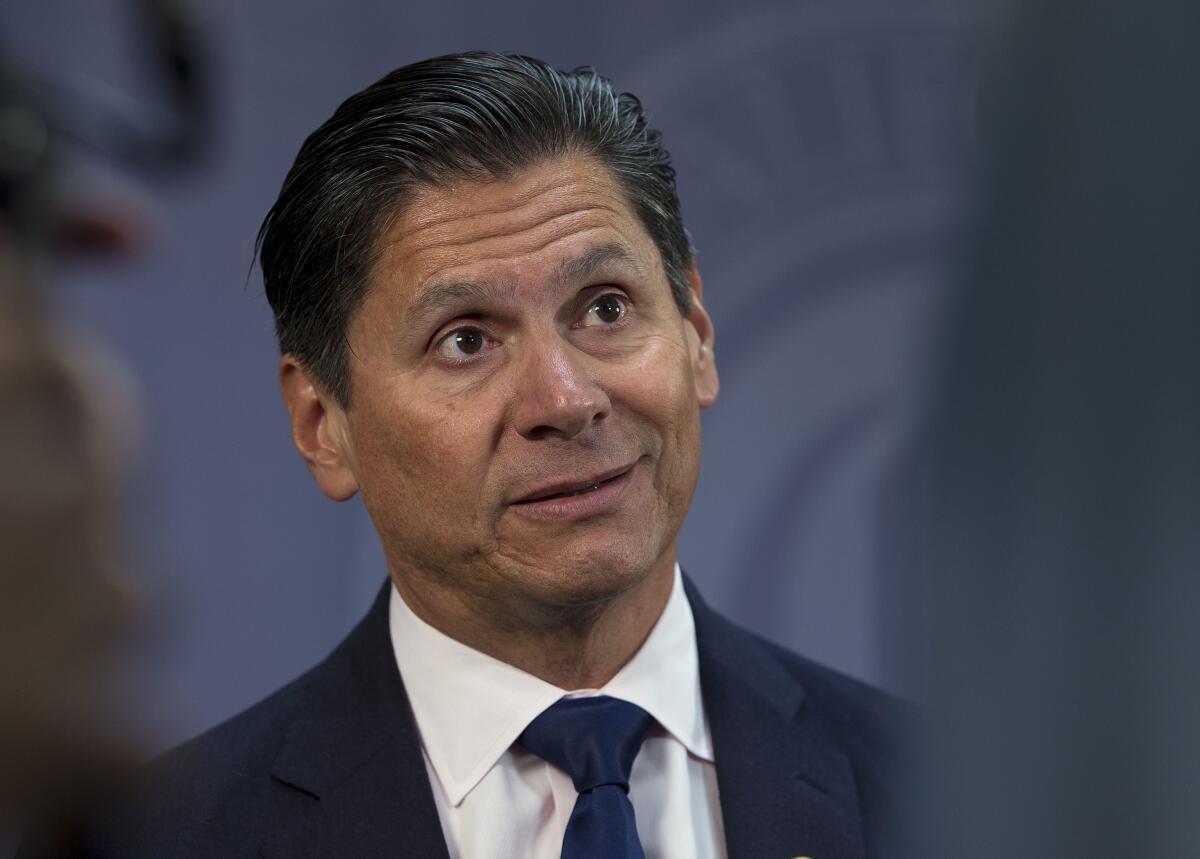California Community Colleges chief to resign as student achievement rises, enrollment plummets

- Share via
California Community Colleges Chancellor Eloy Ortiz Oakley, a champion of equity and access for underserved students, announced Thursday that he is stepping down from the helm of the nation’s largest two-year public college system amid rising academic achievement but declining enrollment.
Oakley, the son of a Mexican immigrant who rose to become the first Latino chancellor of the 116-campus community college system nearly six years ago, will become president and chief executive of College Futures Foundation, an Oakland-based nonprofit focused on college success for the state’s diverse students.
Oakley, who also serves as a University of California Board of Regents member, has been a force to reduce barriers to college access, including eliminating the SAT and ACT as admission requirements and better supporting students aiming to transfer to UC and other four-year universities. He said he would continue that work at the foundation in a role that would allow him to work with all colleges and universities, along with Gov. Gavin Newsom and the Legislature.
“The College Futures Foundation is the loudest voice in California on improving access to the kinds of students that I’ve been fighting for for a long time,” said Oakley, who will step down Aug. 1. The Board of Governors will meet in July to appoint an interim chancellor and launch a search for his successor.
Oakley added that the community college system now has a healthy budget, reforms in place that have improved student achievement and a road map to close equity gaps, increase transfers to universities and boost the number of students earning certificates and degrees. During Oakley’s tenure, the number of students achieving a college credential increased by 32%, and those earning an associate degree for transfer more than doubled, according to system data.
Oakley pushed to end placement testing, which he argued too often underestimated student abilities. He also worked to eliminate remedial classes, which he says is a waste of money and time and derails many students from completing their academic programs. Instead, he advocated that students be supported to succeed in higher-level courses that would count as transfer credits to four-year universities.
A 2017 California law sought to largely eliminate remedial classes — but more than half of the state’s community colleges have not yet made that change. Still, one-year completion of transfer-level courses increased from 49% to 67% in English and from 26% to 50% in mathematics between 2015-16 and 2019-20, according to system data.
The community college system has also adopted a new funding formula that provides more resources to districts serving low-income students and those with demonstrated gains in student success. And the system successfully sued the federal government to stop a policy that could have denied emergency assistance to hundreds of thousands of community college students.
“So I feel that now is a good time to step aside and let the next leader come in and move us forward,” Oakley said of the community college system.
But California community colleges, like counterparts across the nation, are struggling to recover students, who dropped out in droves during the pandemic. Systemwide, more than 260,000 fewer students enrolled in fall 2020 compared with fall 2019, a 16.8% drop. Although the declines have moderated somewhat, enrollment still dropped by 9.9% from fall 2020 to fall 2021, according to a recent report from the National Student Clearinghouse. The system now educates about 1.8 million students.
To combat those declines, Oakley said, colleges need to become more flexible to meet the needs of today’s students, many of whom are juggling work and family responsibilities in addition to school. He said more online and hybrid options, along with more financial aid to free students to study more and work less, could make a difference.
He also said the chancellor’s office needed more authority and staff to direct community college districts to better respond to its directives in the largely decentralized system. Many districts, for instance, have not submitted monthly reports on suspected financial aid fraud as requested by the chancellor’s office after the discovery of 65,000 suspected fake aid applications last year. And with dozens of districts still enrolling students in remedial education, new state legislation aims to close loopholes that allow such courses to continue.
Monica Lozano, the outgoing college foundation president, praised Oakley. As a former UC regent, Lozano said she witnessed his “doggedness” in pushing UC to better embrace transfer students by creating guaranteed paths to admission, increasing their enrollment numbers and providing more support to help them succeed.
“He will operate with a sense of urgency and impatience that I believe we need today,” she said. “We have too long allowed a system to not serve these populations of students, and Eloy is just tireless in his determination to make a difference.”
In a statement, Newsom said he looked forward to working with Oakley to improve higher education’s equity and affordability. The governor and the three public systems have forged an agreement to make specific improvements in college success in exchange for five years of guaranteed funding increases — although the amounts pledged now fall short of keeping up with rampant inflation.
More to Read
Sign up for Essential California
The most important California stories and recommendations in your inbox every morning.
You may occasionally receive promotional content from the Los Angeles Times.











